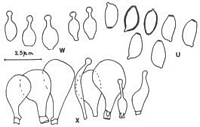|
 Conocybe mesospora Conocybe mesospora
BiostatusPresent in region - Origin uncertain
Images (click to enlarge)
Caption: I-M Horak 61/67, I. Basidiomata with section; J. Caulocystidia; K. Basidiospores; L. Cheilocystidia; M. Basidia. | 
Caption: U, W-X Horak 68/154, U. Basidiospores; W. Cheilocystidia; X. Pileipellis. |
Article: Watling, R.; Taylor, G.M. (1987). Observations on the Bolbitiaceae: 27. Preliminary account of the Bolbitiaceae of New Zealand. Bibliotheca Mycologica 117: 61 p. + 17 pl.
Description: Description of New Zealand material:
Pileus 6-20 mm, convex to campanuiate becoming expanded, argillaceous when wet, to paler honey-brown on drying, hygrophanous, dry, pruinose under hand-lens; margin conspicuously striate when young. Stipe 22.5-42 x 1-1.5 mm, base 2.5-3 mm, cylindric with subbulbous base, pale honey-brown, hollow, ± smooth but pruinose above and appressed fibrillose towards base. Gills adnexed, ventricose, whitish or pale becoming ochraceous rust-colour, with whitish, fimbriate edge. Flesh concolorous. Taste and smell not distinctive.
Basidiospores (7.5-) 8.5-9(-9.5) x 4-5 µm, elliptic in face-view, slightly flattened in side-view, relatively thick-walled, ochraceous brown in both water and aqueous alkali solutions, darker in the latter, non-amyloid, smooth; germ-pore prominent and broad. Basidia 4-spored, hyaline, clavate with very short pedicel, 18-22.5 x 7-9 µm. Cheilocystidia lecythiform, 15-21.5 x 7.5-12.5 (-15) µm, capitulum 3-4.5 µm diameter, hyaline; pleurocystidia absent. Pileipellis a palisadoderm of spheropedunculate to ellipsoid cells, 18-40 x 7.5-12 µm with slightly darkened pedicels and tibiiform dermatocystidia; pilocystidia 25-40 x 4.5-10 µm, capitulum 3-4 µm. Stipitipellis of filamentous, parallel hyphae covered in lecythiform caulocystidia, 20-25 x 10-12.5 µm, capitulum 3-4 µm. Clamp-connections present.
Notes: These collections agree microscopically in all ways with European material.
|